I am trying to run the negative binomial model for the following model. Replicating the results of Table 3 in this paper Association Between Gun Law Reforms
di = ln(ni) + β00 + β10 yeari + ei, i = 1997, …, 2013
where, d = crude death rate, n = person-years at risk and years is from 1997 to 2013.
The above model is used to estimate the trend (measured as the average relative change in death rates per year) in deaths in the periods (1997-2013)
How can I fit this model in R. Any suggestions on Syntax in R. Also can someone please explain what are β00 and β10? How should I select these values?
Below are the values in my dataframe
'data.frame': 17 obs. of 13 variables:
$ X : int 1 2 3 4 5 6 7 8 9 10 ...
$ year : int 1997 1998 1999 2000 2001 2002 2003 2004 2005 2006 .
$ personyearsatrisk: int 18423037 18607584 18812264 19028802 19274701 19495210 19720737 19932722 20176844 20450966 ...
$ suicidegun : int 296 248 261 222 262 213 188 171 145 192 ...
$ homocidegun : int 74 56 51 60 48 50 46 18 20 36 ...
$ massgun : int 0 0 0 0 0 0 0 0 0 0 ...
$ suicidenotgun : int 2351 2393 2229 2170 2208 2115 1976 1948 1951 1952 ...
$ homocidenotgun : int 253 243 247 246 268 243 228 147 171 210 ...
$ suicidetotal : int 2647 2641 2490 2392 2470 2328 2164 2119 2096 2144 ...
$ homocidetotal : int 327 299 298 306 316 293 274 165 191 246 ...
$ avgsuicidegun : num 1.61 1.33 1.39 1.17 1.36 ...
$ avghomocidegun : num 0.402 0.301 0.271 0.315 0.249 ...
$ avgsum : num 2.01 1.63 1.66 1.48 1.61 ...
Below are my values dput(dataframe)
structure(list(X = 1:17, year = 1997:2013, personyearsatrisk = c(18423037L,
18607584L, 18812264L, 19028802L, 19274701L, 19495210L, 19720737L,
19932722L, 20176844L, 20450966L, 20827622L, 21249199L, 21691653L,
22031750L, 22340024L, 22728254L, 23117353L), suicidegun = c(296L,
248L, 261L, 222L, 262L, 213L, 188L, 171L, 145L, 192L, 188L, 184L,
165L, 174L, 145L, 176L, 166L), homocidegun = c(74L, 56L, 51L,
60L, 48L, 50L, 46L, 18L, 20L, 36L, 29L, 26L, 37L, 39L, 32L, 41L,
35L), massgun = c(0L, 0L, 0L, 0L, 0L, 0L, 0L, 0L, 0L, 0L, 0L,
0L, 0L, 0L, 0L, 0L, 0L), suicidenotgun = c(2351L, 2393L, 2229L,
2170L, 2208L, 2115L, 1976L, 1948L, 1951L, 1952L, 2072L, 2141L,
2196L, 2239L, 2329L, 2374L, 2454L), homocidenotgun = c(253L,
243L, 247L, 246L, 268L, 243L, 228L, 147L, 171L, 210L, 199L, 229L,
232L, 202L, 240L, 221L, 184L), suicidetotal = c(2647L, 2641L,
2490L, 2392L, 2470L, 2328L, 2164L, 2119L, 2096L, 2144L, 2260L,
2325L, 2361L, 2413L, 2474L, 2550L, 2620L), homocidetotal = c(327L,
299L, 298L, 306L, 316L, 293L, 274L, 165L, 191L, 246L, 228L, 255L,
269L, 241L, 272L, 262L, 219L)), .Names = c("X", "year", "personyearsatrisk",
"suicidegun", "homocidegun", "massgun", "suicidenotgun", "homocidenotgun",
"suicidetotal", "homocidetotal"), class = "data.frame", row.names = c(NA,
-17L))
I calculated the avgsuicidegun for 100,000 people in a year basically (suicidegun * 100000)/personyearsatrisk and similarly avghomocidegun.
The avgsum is the sume of avgsuicidegun and avghomocidegun
The below image shows the mean rate of firearms death per year trends. Please refer to trend line from 1997 to 2013 in this figure:
 .
.
I am trying to find the Ratio of trends estimate in Annual Death Rate per 100000 Population (95% CI) for deaths involving FireArms
